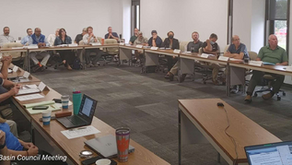Why Minimizing Information Systems Improves Your Asset Management Program
- JD Solomon
- Dec 12, 2022
- 4 min read
Updated: Dec 15, 2022

I love data as a reliability engineer. In fact, I consume data like food – and I have a big appetite. The hardest thing to do is to push away from the table, but that is exactly what you need to do to make your asset management program effective.
These are a few reasons that minimizing the focus of your asset management program on information systems is not as controversial as it first sounds.
Asset Management Is Foundationally About Accounting
Organizations have used and managed their assets to deliver value and achieve their goals for hundreds of years. Every organization determines what it considers value to be and chooses how to derive the best total value.
The formal practice of asset management has become more explicit over the past 40 years. Globally, in the 1980s, an oil and gas crisis in the United Kingdom and service failures in the public sector drove an outcry for more accountability. In the 1990s, asset management gained traction through government accounting standards.
Modern asset management is foundationally concerned with accountability and compliance. The trick is that maximizing asset value is primarily the function of engineering, operations, and maintenance. Operationalizing asset management requires avoiding allowing accountability and compliance from dominating the program’s approach.
Tracking Assets Does Not Operationalize Your Program
Jim Oldach, Kathryn Benson, and I asked and answered the simple question, "Asset Management Gone Bad: Are Trackable Assets Crippling Your Maintenance and Reliability Program?” (proceedings of the 2016 Conference of the Society of Maintenance and Reliability Professionals). Key considerations included:
How do asset-based approaches and system-based approaches fit together from a practical standpoint?
Should preventative maintenance (PM) and predictive maintenance (PdM) programs be performed at the asset or system levels?
Should work orders and cost accounting be tracked at the asset level or the functional location (or subsystem) level?
Where does Reliability Centered Maintenance and focusing on function rather than individual assets fit in?
The conclusion is that most asset management programs are not operationalized because the primary need to improve lifecycle performance is not being addressed. Reliability and maintenance programs are collapsing under the weight of too much detailed data collection and information management that is not useful.
It is ironic the blank stares I get when I ask the simple question, “what is the value of your individual assets?” One would think asset value is an essential component of an asset management program focused on lifecycle. We spend much time collecting data and maintaining information management systems when those aspects often do not include a critical component – asset value.
Organizational Capacity Continue to be the Greatest Challenge
Organizational capacity is a function of three factors – secure harbor, the CID nexus, and organizational culture. The CID nexus is the interaction of personnel capabilities, information, and decision-making processes. Organizations that push major decisions lower in the ranks need better information and highly capable personnel.
Many organizations keep strategic decision making at higher levels of the organization. The fallacy of organizations that focus energy on powerful information systems is that the data is not consumed because the organization does not operate that way.
The shortage of qualified resources in technical fields has been documented for nearly twenty years. That crisis is now upon us. For example, South Carolina Water Environment Federation (WEA) president Earl Sheppard cites, “we face the reality of losing 50% of our workforce to retirement in the next five years.” In all market sectors, reliability and maintenance experts believe the incoming replacements will not have the skills to make strategic decisions.
Most Organizations Do Not Use the Data
In theory, organizations will consume asset management data for reliability engineering and business case evaluations. In practice, few organizations hire personnel, develop business processes, and focus enough time on the results.
Root cause analysis (RCA) guru Bob Latino has described why organizations have a tough time implementing root cause analysis (https://accendoreliability.com/root-cause-analysis-justification-game/). Defect elimination (DE) expert Michelle Henley shares similar concerns and specifically states that a major challenge is being “overly focused on the numbers” (https://www.accelix.com/defect-elimination-programs-change-the-culture-by-solving-lots-of-little-problems-first/).
Latino and Henley agree that organizational improvement is more about the culture than the numbers. Neither cites not having enough data as the core issue when it comes to applying desirable end-game tools like root cause analysis or defect elimination.
Most asset managers are like Don Quixote in search of the elusive destination of Eldorado. Information systems are intriguing but will not produce asset management nirvana.
Gaily bedight,
A gallant knight,
In sunshine and in shadow,
Had journeyed long,
Singing a song,
In search of Eldorado.
But he grew old—
This knight so bold—
And o’er his heart a shadow—
Fell as he found
No spot of ground
That looked like Eldorado.
And, as his strength
Failed him at length,
He met a pilgrim shadow—
‘Shadow,’ said he,
‘Where can it be—
This land of Eldorado?’
‘Over the Mountains
Of the Moon,
Down the Valley of the Shadow,
Ride, boldly ride,’
The shade replied,—
‘If you seek for Eldorado!’
Eldorado by Edgar Allan Poe
Moving Forward
Information systems will not make your asset management more effective. Focusing on information systems will drain your program's energy, enthusiasm, and resources.
The solutions for an effective asset management program include performing a criticality analysis, developing a 20-year financial forecast of renewal and replacement costs, and first addressing the gaps identified by maintenance and operations staff.
JD Solomon Inc provides program development, asset management, and facilitation at the nexus of facilities, infrastructure, and the environment. Contact us if you seek better results from your asset management program.







Comments